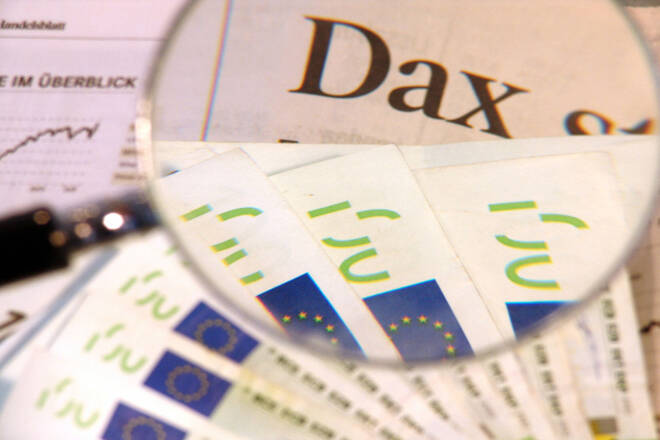Advertisement
Advertisement
DAX Index: Futures Flash Green on Q1 2024 Fed Rate Cut Bets
By:
US economic indicators and central bank commentary will influence market risk sentiment as bets on a Q1 2024 Fed rate cut rise further.
Highlights
- The DAX rose by 0.21% on Wednesday, ending the session at 16,742.
- Rising bets on a Q1 2024 Fed rate cut and economic indicators from China drove demand for riskier assets.
- On Thursday. US labor and housing market data warrant investor attention.
Overview of the DAX Performance on Wednesday
The DAX rose by 0.21% on Wednesday. Following a 0.11% gain on Friday, the DAX ended the Wednesday session at 16,742. The DAX was closed on Monday and Tuesday.
China Industrial Profits Drove the Appetite for Riskier Assets
On Wednesday, industrial profit numbers from China drove demand for riskier assets. Industrial profits were up 29.5% year-over-year in November. Industrial profits had been on a downtrend before the November numbers, declining from +17.2% in August to just +2.7% in October.
News of Beijing changing its stance on gaming contributed to the positive sentiment.
Q1 2024 Fed Rate Cut Bets Supported Riskier Assets
On Wednesday, economic indicators from the US raised bets on a Q1 2024 Fed rate cut. The Richmond Fed Manufacturing Index slid from -5 to -11, with the Services Index down from 1 to 0 in December.
According to the CME FedWatch Tool, the probability of a March 2024 Fed rate cut increased from 70.1% to 72.7% on Wednesday. Significantly, the chance of a January 2024 Fed rate cut rose from 16.5% to 17.6%. 10-year US Treasury yields slid by 2.59%, ending the Wednesday session at 3.798%.
The US equity markets ended the day in positive territory despite the Richmond Fed numbers. On Wednesday, the Dow gained 0.30%. The Nasdaq Composite Index and the S&P 500 ended the day up 0.16% and 0.14%, respectively.
The Wednesday Market Movers
Siemens Energy AG rallied 5.44%, with Bayer gaining 2.32%. News of Bayer winning a lawsuit relating to the Roundup weed killer delivered a positive session. However, there was no Siemens Energy AG-related news to influence investor sentiment.
Auto stocks had a mixed session. BMW and Mercedes-Benz Group saw losses of 0.24% and 0.29%, respectively. Porsche and Volkswagen ended the day with gains of 0.13% and 0.21%, respectively.
US Labor Market and the Fed in the Spotlight
Later in the European session, US jobless claims will garner investor interest. Softer labor market conditions would support bets on a Q1 2024 Fed rate cut. Economists forecast initial jobless claims to increase from 205k to 210k in the week ending December 23.
However, housing sector data also warrants attention. Economists consider housing sector data as leading indicators for the US economy. Improving housing market conditions could support bets on a soft landing. Economists forecast pending home sales to increase by 1.0% in November. Pending home sales declined by 1.5% in October.
Beyond the numbers, ECB and Fed commentary need tracking. Comments relating to inflation and the outlook for interest rates would move the dial.
In the futures market, the DAX and Nasdaq mini were up 48 and 29 points, respectively.
Short-Term Forecast
Near-term trends depend on the expected timing of ECB and Fed rate cuts. Rising bets on a January Fed rate cut could support a DAX return to the 17,000 handle. However, US economic indicators must continue to support bets on a soft landing.
DAX Technical Indicators
Daily Chart
The DAX remained above the 50-day and 200-day EMAs, with the EMAs affirming bullish price signals.
A DAX move through the Wednesday high of 16,776 would bring the December 14 ATH 17,003 into view.
On Thursday, US economic indicators and central bank chatter will impact market risk sentiment.
However, a drop below 16,700 would give the bears a run at the 16,470 support level.
The 14-day RSI reading of 72.03 shows the DAX in overbought territory. Selling pressure could intensify at the 16,850 handle.
4-Hourly Chart
The DAX held above the 50-day and 200-day EMAs, reaffirming bullish price signals.
A DAX return to 16,800 would give the bulls a run at the December 14 ATH 17,003.
However, a fall below the 16,700 handle would bring the 50-day EMA and 16,470 support level into play.
The 55.93 14-4 hour RSI suggests a DAX move through the 16,850 handle before entering overbought territory.
For a look at the economic events, check out our economic calendar.
About the Author
Bob Masonauthor
With over 28 years of experience in the financial industry, Bob has worked with various global rating agencies and multinational banks. Currently he is covering currencies, commodities, alternative asset classes and global equities, focusing mostly on European and Asian markets.
Advertisement
